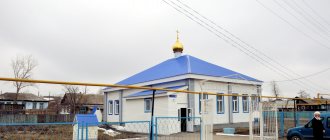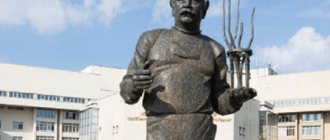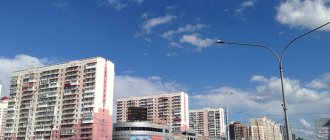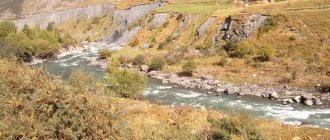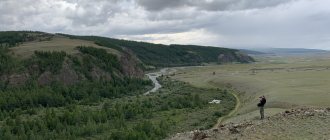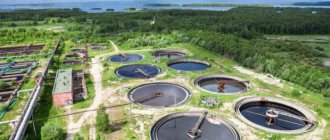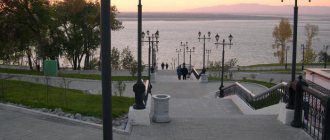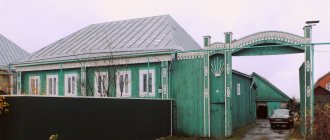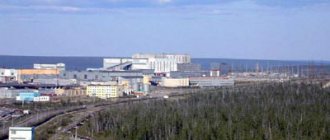Bashkiria, or officially the Republic of Bashkortostan, is located in the southern part of the Ural Mountains, on the border of Europe and Asia. The name comes from the name of the indigenous Bashkir people (Bashkort).
The territory of the republic is located in the basins of the Volga , Ural and Ob . Bashkiria is interesting for its rich and beautiful nature with a wide variety of landscapes, as well as national flavor.
The capital of Bashkiria is the city of Ufa. The largest cities are Ufa (1.124 million people), Sterlitamak, Salavat, Neftekamsk and Oktyabrsky.
Bashkiria borders on the following territories of the Russian Federation:
- with the Republic of Tatarstan in the west,
- with Udmurtia in the northwest,
- in the north - with the Perm Territory and the Sverdlovsk Region,
- with the Chelyabinsk region in the east,
- in the south and southwest - with the Orenburg region.
Geographical characteristics of the Republic of Bashkortostan:
Area 142,947 km² (27th place in Russia). The length from north to south is 550 km, from west to east – 430 km. Population 4,038,151 (2020). The population density is 28.4 people/km², the share of the urban population is 62%.
Statistics, however, say that Russians predominate in the national composition of the population - 36%, followed by Bashkirs - 29%. There are 25% Tatars in the republic, 2.7% Chuvash, 2.6% Mari, etc. In total, representatives of 160 nations live.
There are two official languages on the territory of the republic - Bashkir and Russian. There are many signs in Bashkir, or in both languages.
Story
The republic and its inhabitants were first mentioned in written materials from the 10th century. The numerous mountains of Bashkiria were inhabited by one part of the indigenous people, the other part lived in the free steppes. Their main activities are hunting, cattle breeding and fishing.
In the 12th-14th centuries, the Bashkirs were oppressed by the Tatar-Mongols; after the collapse of the Horde, the very existence of the people was under threat - the people were suppressed and divided. In 1557, a decision was made to join the Russian state. Gradually, the territory of Bashkiria begins to be populated. Several fortresses were founded to protect against enemy raids. Local residents adopted Russian farming experience. In the 18th century, the Southern Urals became the center of the mining industry.
The Bashkirs took an active part in the Peasant War. Their detachment was led by the poet and talented military leader Salavat Yulaev, who was captured by the government and sent into exile after the defeat. He subsequently became a national hero.
With the advent of the Soviets, an autonomous republic was formed. In 1992, due to the collapse of the USSR and the change of government, it was renamed. The beautiful region was named the Republic of Bashkortostan. This is how we know him today. To the question “how old is Bashkiria?” It’s difficult to answer definitively. The republic was formed as an independent region more than 700 years ago. But its birth dates back to the middle of the 15th century - it was then that it was annexed to Russia.
Bashkortostan today
Today the Republic of Bashkortostan is part of the Russian Federation, being at the same time a sovereign state with its own president, Constitution and legislative body of state power (State Assembly - Kurultai of the Republic of Bashkortostan).
In 2007, Bashkiria celebrated the 450th anniversary of its annexation to Russia. They celebrated on a grand scale; Ufa became especially noticeably prettier for this significant date: 40 objects were restored and built in the capital, including the luxurious congress hall “House of Friendship of Peoples,” an international airport, a hippodrome and an ice palace. Residents of Bashkiria feel like Russians and intend to continue to live with Russia in peace and harmony, but at the same time, of course, they are proud of their national history and cultural traditions and are happy to demonstrate their original features to guests.
A guest arriving in the Republic of Bashkortostan for the first time may think that the monopoly on food trade here belongs to a retail chain with the mysterious name “Azyk Tulek”, because there is such a sign above all the stores. The explanation for this comes later: all names in Bashkiria are written in two languages - Bashkir and Russian, and the language Tulek is translated as food.
Bashkiria Square
The republic is located in the southern part of the Ural Mountains, at the border of Europe and Asia. The Perm, Sverdlovsk, Chelyabinsk, and Orenburg regions are located nearby. In the west and north-west it neighbors Tatarstan and Udmurtia, respectively. The exact area of Bashkiria is 143,600 thousand square kilometers (this is 0.8% of the entire territory of Russia).
The capital of the republic is the city of Ufa. Beloretsk, Ishimbay, Kumertau, Neftekamsk, Salavat, Sibay, Sterlitamak are the large cities that Bashkiria can boast of. The language with which its inhabitants communicate is Russian. They also speak their native Bashkir, and in some areas people communicate fluently in Tatar. The population of the republic (according to the 2010 census) is 1,172,287 people. There are about 2 million Bashkirs in the world.
The area of the Republic of Bashkortostan is larger than the area of the following countries:
Greece (131,957 sq. km.), Nicaragua (130,370 sq. km.), North Korea (120,538 sq. km.), Malawi (118,484 sq. km.), Eritrea (117,600 sq. km.), Benin (112,622 sq. km. .km.), Honduras (112090 sq.km.), Liberia (111369 sq.km.), Bulgaria (110879 sq.km.), Cuba (110860 sq.km.), Guatemala (108889 sq.km.), Iceland (103,000 sq. km.), South Korea (99,720 sq. km.), Hungary (93,028 sq. km.), Portugal (92,090 sq. km.), Jordan (89,342 sq. km.), Azerbaijan (86,600 sq. km. .km.), Austria (83871 sq.km.), United Arab Emirates (83600 sq.km.), Czech Republic (78867 sq.km.), Serbia (77474 sq.km.), Panama (75420 sq.km. ).
Weather and climate
The climate of the republic is continental. The weather in Bashkiria is changeable and sometimes unpredictable. The low mountain range does not prevent the penetration of Siberian air masses.
Summer in the republic is warm. The temperature in the steppe zone of the foothills of the Urals rises to 40 degrees. On average, in July the temperature ranges from 16 to 20 °C. The number of sunny days in the capital is around 260. Winter in Bashkiria is quite severe. The negative temperature stays around 15 degrees, but sometimes the thermometer drops to -40 °C. Snowstorms are typical for the steppes, blowing snow away from the elevated areas of the valleys of the Urals. Snow appears in September and lasts until April. The weather in Bashkiria directly depends on the wind; on average, it develops a speed of 3.4-5.2 meters per second.
Climate
The climate is continental. Winter is correspondingly snowy and long. Summer is moderately warm. In January the average temperature is -19°C in the north -16°C in the south. In July – from +18°С in the north to +21°С in the south. Precipitation amounts to 640–700 mm on the western slopes of the Urals, and in the east it does not exceed 300–500 mm, and in the flat part – 400–500 mm. The growing season lasts 140–160 days.
The territory of Bashkiria is located in the forest zones of the Southern Urals, forest-steppe, and steppe. Forests occupy more than 40% of the area. Different forests:
- mixed forests in the Urals,
- in the western foothills, mountainous regions and the Bashkir Trans-Urals there are pine-deciduous, birch forests and dark coniferous taiga.
In the Cis-Ural region there are also forest-steppes with birch and oak forests and steppes.
77 species of mammals, about 300 species of birds, 42 species of fish, 11 species of reptiles, 10 species of amphibians, and 15 thousand species of insects have been registered on the territory of Bashkiria.
Transport accessibility
The main transport arteries of the country pass through the territory of Bashkiria - federal highways M5 and M7, as well as the Moscow-Vladivostok railway. And Ufa International Airport is one of the best in the country. It receives aircraft of all types from many cities in Russia and abroad.
Recreation and tourism in Bashkiria
The unique nature and cultural and historical heritage of the Republic of Bashkortostan attracts an increasing number of tourists every year. Service and infrastructure are developing. The nature here is distinguished by its bright colors, which are combined with special climatic conditions and the friendliness of the residents, which will leave only pleasant memories and positive emotions.
Tourism in Bashkiria rests on three pillars: health, sports and adventure. For this, the republic has everything necessary: beautiful nature, intoxicating mountain air and many unique historical and cultural monuments. The history of the region is full of events that are of interest to curious people, and lovers of active recreation can try their hand at various fields.
For active people, Bashkiria opens up new horizons and allows them to dramatically change their usual way of life for a while. In a short period of time you can experience new sensations and gain a boost of energy. The Ural mountains with mysterious caves, dense forests, lakes and rivers with clear water, and endless steppes await you.
Nature
Most tourists come to the republic to admire the diversity of its nature. When traveling around Bashkiria, be sure to look into the coniferous and deciduous forests. Noble oaks, light lindens, Norway maples, and sharp firs are located proudly and majestically in them. The area is rich in magnificent flora and diverse fauna - animals characteristic of the taiga live in these forests. Mice, jays, badgers and hedgehogs are only a small part of the animals that may catch the eye of a tourist.
The forest-steppe of Bashkiria is rich in foxes, wolves and hares, and in some places you can find roe deer. The most open areas are inhabited by steppe rodents. Seagulls and ducks settled near the lakes. The steppe area is sparse with trees, there are few plants here, and cereals grow - sheep and feather grass. Local residents include gophers and jerboas. There are many birds of prey - golden eagles, eagles, kites. They can often be seen hovering in the air or sitting on slopes - this is how they observe and look out for prey. The steppe lakes of the Trans-Urals are teeming with birds, and near the rivers you can meet the inhabitants of the neighboring forests.
The area of the Republic of Bashkortostan is 5 times or more greater than the area of such countries as:
Equatorial Guinea (28,051 sq. km.), Burundi (27,830 sq. km.), Haiti (27,750 sq. km.), Rwanda (26,338 sq. km.), Macedonia (25,713 sq. km.), Djibouti (23,200 sq. km. .km.), Belize (22966 sq.km.), El Salvador (21041 sq.km.), Israel (20770 sq.km.), Slovenia (20273 sq.km.), Fiji (18274 sq.km.), Kuwait (17,818 sq. km.), Montenegro (13,812 sq. km.), Qatar (11,586 sq. km.), Gambia (11,295 sq. km.), Jamaica (10,991 sq. km.), Kosovo (10,887 sq. km.) km.), Lebanon (10,400 sq. km.), Cyprus (9,251 sq. km.), Brunei (5,765 sq. km.), Samoa (2,831 sq. km.), Luxembourg (2,586 sq. km.), Hong Kong (1104 sq. km.), Singapore (697 sq. km.), Barbados (430 sq. km.), Malta (316 sq. km.), Maldives (298 sq. km.), Liechtenstein (160 sq. km. .).
Mountains of Bashkiria
The main attraction of Bashkortostan is its magnificent mountains. The largest mountain of the Southern Urals is located here - the Yamantau hill with two peaks, from which numerous rivers flow. Another popular mountain is the sacred Iremal, which was strictly forbidden to climb until the 19th century. Mount Premel is the mother of two rivers, by swimming in which you can recharge yourself with remarkable strength for the long year ahead.
There are legends about the appearance of the Yurak-Tau, Kush-Tau, Shah-Tau and Tra-Tau mountains. It is believed that many years ago the arrogant horseman Ashak was in love with the daughter of the old Ural, the beautiful Agidel. He tried to attract the girl's attention, but his feelings were not reciprocated. Ashak then mounted his horse and chased his beloved. Having caught up, he hit her with a whip, which angered old man Ural. He turned his daughter into a fast river, and Ashak could not catch the naughty Agidel - the water flowed through his fingers.
He decided to send a falcon after the girl, but he also failed. Ashak realized everything, tore his own heart out of his chest, and threw it at the feet of his beloved. She touched him, but could not return to human form. Now at the site of the tragedy there are four shihans - Yurak-Tau (heart), Kush-Tau (bird), Shah-Tau (Ashak) and Tra-Tau (mountain of the Bashkir tribe).
Rivers
Rivers, like mountains, are the pride of this beautiful republic. The largest and strongest river in Bashkiria is the Belaya. It flows, meandering through the Cis-Urals and along the western foothills. Its tributaries are the Nugush, Sim, Ufa and Dema rivers. In November, after severe frosts, the rivers quickly freeze. After 5 months they gradually thaw.
In areas of forests and steppes one can count a huge number of lakes of varying sizes. They are wide but shallow, and many of them are overgrown with reeds, cinquefoil and other marsh vegetation. The lakes are different - fresh, salty, but they are all beautiful in their individuality.
Nature reserves
A large area of Bashkiria is occupied by valuable natural reserves.
- State reserve. It is located on the border of deciduous and birch forests, close to the Trans-Ural steppes. The flora and fauna are very rich; both mammals and large predators live here. The reserve's workers monitor the conservation and breeding of birds and animals, many of which can be found in the Red Book.
- Shulgan-Tash. There are no analogues to this place in the Russian Federation - wild bees are protected and studied on the territory of the reserve. They easily tolerate cold and are resistant to diseases, and their productivity is many times higher. Rare birds are also protected in the reserve.
- Bashkir National Park. Filled with rare species of plants and animals. Tourists have the opportunity to walk along ecological trails (specially designed routes).
Sights of the Republic of Bashkortostan
Bashkiria National Park is located on the western ridges of the Southern Urals in the interfluve of the Nugush and Belaya rivers, on the Yamantau, Kibiz, Utyamysh, Bash-Alatau ridges (the average mountain height is 500-700 m), as well as the adjacent territories to the south. The total area is 82.3 thousand hectares, the territory is divided into several zones; written permission from the administration is required to visit specially protected areas. Tourists are offered walking ecological routes, riding along the reservoir, short horseback rides and horseback riding tours lasting several days. The natural beauty of the park will not leave anyone indifferent: while taking a walk along the Nugush Reservoir, you can admire the view of the picturesque rocks, climbing the mountain - look at the endless forests, visit the caves, visit the foot of the waterfalls, or just breathe clean air and enjoy the diversity of the rich flora and fauna of the park .
The Bashkir Nature Reserve is home to about 700 species of plants, more than 50 species of mammals and more than 150 species of birds.
The Bashkir Nature Reserve, located in the Burzyansky district of the republic, is home to about 700 species of plants, more than 50 species of mammals and more than 150 species of birds. There are 2 ecological trails for hiking along the territory of the reserve, the journey along which will take no more than an hour and a half. For those who like long walks, routes along the boundaries of the reserve are offered.
The Shulgan-Tash Nature Reserve, located in the western foothills of the Southern Urals, has federal status. Its main attraction is the Shulgan-Tash cave, also known as Kapova. The reserve is also notable for its wild honey. After all, it is in the Burzyansky district, on the territory of the Shulgan-Tash and Altyn-Solok nature reserves, that beekeeping has been preserved - a traditional occupation of the Bashkirs since ancient times. Today, Bashkortostan is the only place in Europe where the collection of wild honey continues, and the Burzyan bee, a unique population of bees that has remained unchanged since ancient times, is a real jewel of the republic, which has even become an unofficial symbol of the celebration of the anniversary of the unity of Bashkiria and Russia.
Bashkortostan and the Southern Urals are rich in other natural attractions, as well as small colorful villages, for example, the village of Kaga, in the Beloretsk region.
Ski resort Abzakovo
Abzakovo is located almost at the very border with the Chelyabinsk region. The popularity of the resort grew sharply after the then Russian President V.V. Putin visited it in 2000. The cable car also operates here in the summer, so anyone can climb to the peaks of the Ural Mountains, spending half an hour admiring the surroundings and not getting tired at all.
Modern Bashkiria
Bashkortostan is one of the most economically stable regions of the Russian Federation. The republic has a developed industry, and the capital is ideal for doing business (according to Forbes ratings). The living wage in Bashkiria is set by the government at 8,691 rubles per capita. For workers - 9205, for pensioners - 7061, for children - 8856.
Grain and industrial crops are grown in the fields, and sheep, horses, and poultry are grown on farms. Wool production and beekeeping are popular. Oil refining, mechanical engineering and metalworking are developed in the republic. Factories in Bashkiria are engaged in woodworking and the production of building materials.
There are 1,644 preschool institutions, 1,587 schools and 10 state universities on the territory of the republic.
Tourism sector
Tourism is one of the main areas in the life of Bashkiria. It is often called the second Switzerland due to its diversity of natural resources. When planning a trip, rest assured: they can offer you different options for relaxation in sanatoriums and resorts. You can stay at camp sites, comfortable hotels or budget hostels.
The Republic of Bashkortostan offers its guests to take advantage of numerous tourist routes. You can choose from hundreds of summer and winter bus tours, including through the capital and nature reserves. For lovers of horse riding, rafting on catamarans or kayaks, there is also fun. You can book a ski or cycling tour, snowmobile safari, trekking, caving tour or a simple sightseeing walk.
Attractions
Bashkiria has attractions for almost every taste. You should not ignore the capital - the city of Ufa.
The main symbol of the city and the republic was the monument to the national hero Salavat Yulaev. When you travel by train, you will see how majestically it stands on the high bank of the river.
A separate article needs to be written about the sights of Ufa, so I’ll move on to a description of the territory of the republic.
Bashkiria is rich in beautiful rivers that are suitable for both extreme sports lovers and families for a relaxing holiday. Therefore, these places are very popular among water tourists. The most popular rivers for rafting:
- White (Agidel),
- Ay,
- Yuryuzan,
- Zilim,
- Inzer,
- Lemeza,
- Nugush and others.
Majestic cliffs rise along the banks of the rivers. You can choose kayaks, large rafts, catamarans.
Your companions will be very picturesque shores, songs around the evening fire, porridge and soup with smoke, sincere conversations, berries and mushrooms, fishing and mosquitoes. But a real tourist is not afraid of mosquitoes!
Bashkiria is indeed very rich in its nature. Mountains and caves, rivers and the huge expanse of water of the Pavlovsk reservoir attract tourists and outdoor enthusiasts.
A unique monument of nature and history is the Kapova Cave with ancient rock paintings.
Since it is located in the Shulgan-Tash nature reserve, visits are limited to only the first grotto, and the drawings can be seen in reconstructions. In the same reserve you can get an idea of the Bashkir folk craft - beekeeping.
In Bashkiria there is the largest waterfall in the Southern Urals - Gadelsha .
The most beautiful and original waterfall in the Urals, Atysh, is also located here. There are many other waterfalls: Abzanovsky, Kuk-Karauk, Kuperlya, Mogak, Sharlama and others.
On the Ufa Plateau there are interesting karst springs, including the largest spring in Russia - Krasny Klyuch. It is worth visiting an even more beautiful similar place – the spring lake Sarva. There is a similar object near Ufa - Blue Lake.
In the flat part, the Sterlitamak Shihans rise majestically. Alas, some of them became raw materials for the production of soda.
It is interesting to see the Inzerskie Zubchatki.
Ski resort Abzakovo
Winter holidays in Bashkiria are also possible. The Abzakovo resort is located almost at the very border with the Chelyabinsk region, which is why ski lovers come here from there.
The popularity of the resort grew sharply in 2000 after Russian President V.V. Putin visited it. You can come to Abzakovo in the summer. The cable car operates here all year round, so anyone can climb to the tops of the Ural Mountains, spending half an hour admiring the surroundings and not getting tired at all.
National cuisine of the Republic of Bashkortostan
Bashkir cuisine is distinguished by an abundance of meat in almost all hot dishes. You can often find variations of the pie filled with meat and potatoes.
Festive dishes - belesh, bishbarmak, chicken broth with especially thin and crumbly noodles (tukmas). Muslim traditions are widespread in the republic, so you rarely see pork in the Bashkir diet. But boiled beef, lamb, dried and dried horse meat are popular; pastry; fermented milk products - kurut, sour cream; sweets - chak-chak, honey; kumis is a national drink made from mare's milk.
Bashkirs drink a lot of tea and always with milk. It is especially tasty if prepared according to tradition, when milk is poured into a cup first, and then strongly brewed tea.
Bashkiria has long been famous for its honey. Nowadays, the fame of Bashkir honey has spread far beyond the borders of the republic - it is supplied to Europe, the USA, and Japan. It is worth noting that only the State Institution “Bashkir Research Center for Beekeeping and Apitherapy” can use the phrase “Bashkir honey” to label its products; this is a patented brand.
Ufa is the capital of Bashkiria
Ufa is located in the very center of Bashkiria, at the confluence of three main rivers. The history of the city dates back to 1574 - then Ufa was the first Russian fortress. Gradually spreading its influence to all corners of the republic, the fortress held its defenses and repelled enemy attacks.
The city has numerous theaters open to visitors, where you can see drama and comedy, opera and ballet, and watch puppet shows. Tourists can spend their time in the city's national and art museums, as well as look at religious monuments and go to modern cinemas.
Ufa is a very beautiful and picturesque city. Along the edges of busy highways there are linden, poplar and maple trees in even rows. Houses give way to parks, and parks to houses. The main highlight of the city is the views across the river. They are visible even to the naked eye: in the distance you can see the green floodplain, pouring out the bends of lakes and rivers that slowly go to the horizon. A little further you can see round hills covered with bright greenery. In the west is the luxurious valley of the Dema River with creeks, forests and beaches - favorite vacation spots for city residents.
Head of the Republic
In 2014, Rustem Zakievich Khamitov was elected to a second term. His political career began with his appointment as chairman of the Commission on Environmental Problems, then he worked as director of the institute, and in 1994 he became Minister of the Environment. Behind him are many years of work in the structure of the Ministry of Emergency Situations. In 2010, the former president of Bashkiria, Murtaza Rakhimov, resigned. Rustem Khamitov was appointed in his place by Dmitry Medvedev. The State Assembly of the Republic supported his candidacy. On July 15, 2010, Rustem Zakievich Khamitov officially began working in this responsible position.
Khamitov instills in young people a love of sports and develops international relations. The President of Bashkiria travels throughout the republic and actively participates in its entire life.
What to bring from Bashkiria
Traditional Bashkir souvenirs also include sets of wooden utensils with Bashkir ornaments, cobweb shawls and national clothing. Matryoshka dolls, Bashkir dolls, brooms, amulets, and bells are in great demand .
Bashkir balms are a source of longevity, discovered by ancient nomads. Traditionally, tourists buy this unique drink as a souvenir: local balms can be drunk for both pleasure and healing purposes. Bashkir balms contain only natural ingredients, so they are used as a valuable medicine. The preparation of such drinks requires a lot of experience and knowledge and a time-tested recipe, because the drinks contain a variety of components.
Bashkir honey has long become a brand of the republic - it is valued throughout Russia, the Chinese love it very much, and they are credited with healing properties.
For the first time, the benefits and uniqueness of Bashkir honey were recognized back in 1900 at the international fair in Paris. Long before this, honey from Bashkiria was used and appreciated by local residents. This is evidenced by ancient records and even rock paintings found on the territory of Bashkortostan by archaeologists.
Bashkir honey is made from natural linden, which is why it has the second name “lipets”
Cosmetics based on honey . Many people don’t even realize that cosmetics for skin and hair care are made from honey. For just 1000 rubles you can put together a good set of moisturizing hair balm, nourishing honey mask, propolis scrub and tonic with royal jelly. The choice of care products is huge. Moreover, despite their high efficiency, they are inexpensive.
Save it for yourselfPrint
0
Author of the publication
offline 3 hours
National cuisine
- Bishbarmak is boiled horse meat or lamb, cut into pieces. As a side dish - noodles with meat broth.
- Dried horse meat sausage.
- Salty and sour cheese curds (short).
- Berry marshmallow.
- Kumis is a milk drink made from mare's milk. It tastes sour, but the benefits of kumiss are appreciated all over the world.
- Buza is a drink made from sprouted grains of rye or barley.
- Ayran is sour milk diluted with water. An ideal assistant in the fight against thirst.
Traditional clothing
A long shirt with a turn-down collar and a short sleeveless vest (kamzul) worn on top is the basis of the men's national costume. Warm sheepskin in winter or a warm robe (zhilyan). On the feet are boots with cloth shins and soft leather ends (saryk) and hand-made leather shoes (kata). The poor had to wear bast shoes. You could put a skullcap on your head, and on top - a hat made of otter or beaver fur.
The woman's clothes are wide, long dresses to the toes, embroidered with multi-colored ribbons along the hem. They went out into the world wearing an apron with rich embroidery and a sleeveless vest trimmed with tinsel at the edges. Robes decorated with plaques and beads were used as outerwear; in winter, a fur coat was used. Headwear - a chintz scarf and a fur hat. The shoes are similar to men's: saryk with embroidery, kata with heels. Girls from wealthy families wore various jewelry: rings, necklaces, bracelets, earrings, pendants.
Nowadays, you can see traditional costumes on older people or during special events, as well as when performing folk dances and songs.
Ceremonial events
- Bashkiria Day is associated with the adoption of the Declaration of State Sovereignty of the Republic. It is celebrated on October 11.
- Constitution Day – December 24th.
- Eid al-Fitr is celebrated in accordance with the lunar calendar. A holiday in honor of the end of fasting in the month of Ramadan.
- Kurban Bayram - like the previous holiday in Bashkiria, is appointed according to the lunar calendar. This is an Islamic holiday commemorating the sacrifice of the Prophet Ibrahim.
- Sabantui. The time of celebration is set by government decree. Held in honor of the end of spring field work.
- Salauat yiyiny is another holiday in Bashkiria, a republican folklore holiday in honor of Salavat Yulaev.
Places worth visiting
Are you walking around Ufa? Visit the monument of Bashkir architecture - the mausoleums of Husein-Bek and Keshene (translated as “house of decay”). Located 40 kilometers from the capital, the time of their construction is the 11th and 13th centuries, respectively.
In the Shulgan-Tash Nature Reserve, do not pass by the Kapova Cave (the right bank of the Belaya). Having three floors with a total length of 1.8 kilometers, it is a significant archaeological monument. On the territory of the Bashkiria National Park there is a natural Kuperlya bridge. Many years ago, the river cut through an underground channel, creating a large cave, which collapsed over time and created a work of art - part of which continues to hang over the river as a bridge.
In Birsk you can learn everything about the folk crafts of the indigenous peoples of Bashkiria. There is an art products factory here that produces souvenirs from capo root (a growth on the roots and trunks of birch trees) and various clay products.
The republic boasts many cultural monuments, as well as places that are not - they are simply very beautiful. Guests of Bashkiria love to visit the Ufa Plateau (along the Ufa River). The view is beautiful: a fast river framed by green forests, caves and funnels, gushing springs - all this will take your breath away!
The nature of Bashkiria amazes with its unique and inexplicable beauty. It is impossible to describe all its beautiful places in words, but you can see them in person. When planning a trip, be sure to think about Bashkiria - a wonderful region with rich nature.
Bashkortostan
Bashkortostan includes 8 cities of republican significance, including the capital of the republic, Ufa, as well as such large cities as Sterlitamak, Salavat, Neftekamsk, Oktyabrsky. The territory is divided into 54 districts, which include 12 cities of regional significance and 2 workers' villages.
If we take into account the natural features of the region, we can divide it into 3 zones - the Bashkir Urals, Mountain Bashkiria and the Bashkir Trans-Urals. Each of them has characteristic features and attractiveness for tourists.
Bashkir Urals
A significant part of the population lives in this territory; the main large cities are concentrated here, including the capital. Along with cultural attractions, it can offer travelers natural beauty - caves, waterfalls, mountain canyons.
Ufa
Monument to Friendship
© Lyubov Razumkova
The founding date of the city is considered to be 1574, however, thanks to archaeological finds, it was possible to establish that people lived in this territory already in the 4th–3rd centuries BC. e. It performed a defensive function - the built wooden fortress protected the population and the eastern borders of the Russian state from attacks by peoples living in the steppe territories. It was also the place where the in-kind tax from the Bashkirs was received, which they paid to the Russians in exchange for help in defense against external enemies.
The modern city can boast of high rates of industrial development. The large number of nationalities living in it left their mark on its architectural appearance and flavor. There are so many facets and combinations of different cultures, traditions and religions that sometimes, looking through photographs of streets and attractions, it seems that this is not one city, but several completely different ones. This diversity may be what attracts tourists.
Unfortunately, the Ufa Kremlin has not survived to this day, it was destroyed by fire and the events of Pugachev’s uprising, but there are many more recent historical buildings that adorn the city. It is also interesting to appreciate the architecture of religious buildings here; Muslim buildings - mosques, madrassas and Christian churches - are amazingly coexistent in the city. There are also monuments in the city to personalities who played a role in the history of the republic, as well as monuments dedicated to significant events.
Cathedral of the Nativity of the Virgin Mary
© Lyubov Razumkova
Ufa is a green city, there are many parks and gardens that are pleasant to stroll through. In one of these environmentally friendly zones there is a local sanatorium.
Do you like boat trips? Then be sure to take a boat or boat ride on the Belaya River. The city also has an equipped sandy beach, where locals like to relax on warm days.
During the cold season, a trip to a water park can be an interesting family pastime. In winter, ski resorts located within the city are popular among tourists.
If you are a connoisseur of cultural entertainment, visit one of the city's theaters. Or take a look at the museums, they will help you learn more about the rich history of the city and the republic, and experience the traditions of the indigenous people.
Guide to Ufa Stories and reviews from tourists
Sterlitamak
This city, located approximately 125 km from Ufa, was founded as a salt marina, and later industry began to develop here. For a short period of time, it even became the capital of the Bashkir Autonomous Soviet Socialist Republic. Modern Sterlitamak can boast of success in industrial production and the agricultural sector.
Shikhan Toratau
© Ulyana Stepashova
Taking a walk around the city, you can see several preserved architectural monuments of the late 19th and early 20th centuries - residential buildings, buildings of various institutions. The city also has a local history museum, an art gallery and theaters. Within the city limits you can also enjoy nature by visiting the boat station, here you can rent a catamaran, boat or canoe, cook barbecue or just relax by the Belaya River.
In the vicinity of the settlement, there are shihans - isolated mountains that are the remnants of a barrier reef that was formed in the ancient ocean that existed in the area hundreds of millions of years ago. At the foot of Mount Kushtau there is a holiday home with a ski slope.
Information about Sterlitamak Reviews from tourists
Ishimbay
The first oil field in the republic was discovered in this area; initially, an oil workers’ settlement was formed, which eventually received the status of a city. In its vicinity there are several natural attractions of interest to tourists, including a shihan, a waterfall, rocks and caves, a karst spring, and numerous rivers.
Information about Ishimbay Reviews of tourists
Meleuz
The city, located 210 km from Ufa, has several historical architectural structures. However, it is more interesting to visit its surroundings. For example, in the village of Nugush there is the Bashkiria National Park. On its territory there are several caves, a reservoir, a tract, and a karst bridge. Various routes have been developed for tourists to get acquainted with the diversity of nature in the park. There are several recreation centers and a sanatorium nearby.
Information about Meleuz
Belebey
Founded by Chuvash settlers, it became a county town in 1781. The discovery of the Shkapovskoye oil field in 1953 contributed to its development.
Aksakov Family Museum in Nadezhdino
© Group of the Aksakov Family Museum on VKontakte
Several historical buildings have been preserved in the city itself, and in the surrounding area there are museums associated with creative personalities.
One of them is located in the village of Nadezhdino, where the Aksakov family had their family estate. Nowadays, there is a museum dedicated to the famous native of the republic - writer Sergei Aksakov - and his descendants.
There is also a Tsvetaeva museum in the Belebeysky district. It would seem, what does the poetess have to do with these places? It turns out that in her youth she vacationed in the village of Usen-Ivanovskoye and was treated with kumys along with Sergei Efron, her future husband. He was sick with tuberculosis, and this drink is known to be used to treat the disease.
Information about Belebey
Birsk
Founded in 1663, Birsk intricately combines echoes of the past with a modern appearance. On the streets you can see many merchant houses, reminiscent of the fact that it was thanks to trade that the city began to actively develop.
In addition, the city is famous for its apple orchards; they say that it becomes especially charming when these trees bloom.
Not far from it in the Birsky district there are several more interesting attractions - Lake Shamsutdin with a rest house and a tourist base on its shore, Birsky and Urzhum mineral springs.
Information about Birsk Reviews of tourists
Krasnousolsky
Sanatorium "Krasnousolsk"
© Group of the sanatorium "Krasnousolsk" VKontakte
In the middle of the 18th century, a copper smelter was built in this area, at which a village was formed; later it was reoriented to glass production. Nowadays, the factory buildings are recognized as an architectural monument, and excursions are even organized here.
Now the village is famous for its sanatorium, which uses mineral springs and healing mud to treat patients. The local microclimate also contributes to health improvement.
You can also visit the Krasnousolsky mineral springs on your own and plunge into the pools with healing water.
Not far from the village there is also a house-museum dedicated to the Bashkir poet Mazhit Gafuri.
Mrakovo
The greatest interest in this village is the Muradymovskoe gorge with numerous caves and marvelous nature. In some caves you can see rock paintings and sites of ancient people.
Mountain Bashkiria
This is the territory of the Southern Urals, covered with forests. Famous for its nature, here you can really feel unity with it far from civilization. The area is distinguished by diverse vegetation, among which there are rare species, and a rich fauna.
Beloretsk
The date of its foundation is considered to be 1762. Initially, it was a settlement at a factory that was engaged in smelting cast iron. Some of his buildings have survived to this day. The city has a ski center where not only athletes train, but also amateurs ski.
A significant area of the Beloretsk region is covered with forests, and there are many natural tourist attractions. Among them are the South Ural State Nature Reserve, mountains, caves, rocks, waterfalls.
Information about Beloretsk Stories and reviews from tourists
Assy
The village, located 115 km from Beloretsk, is known for its healing mineral springs.
Sanatorium "Assy"
© Group of sanatorium “Assy” on VKontakte
Local residents have known about their beneficial properties for a long time and have successfully used them to treat many diseases. There is even information that the water from the springs was used to treat royalty - supposedly Catherine II took baths with it.
The studies carried out indicate similarities in the properties of local springs with those located at the famous resort in Baden-Baden.
There is a modern sanatorium in the village, which has the necessary equipment and natural resources for the health of patients.
Starosubkhangulovo
The village is the administrative center of the Burzyansky district, which is notable for its untouched nature, harsh and beautiful. There are many forests inhabited by bears and deer. To protect natural resources, nature reserves were created - the Bashkir State and Shulgan-Tash, as well as natural parks.
The traditions of beekeeping are preserved on the territory; this honey has its own characteristics and is very highly valued. Tourists can see a cave with rock paintings here, walk along ecological trails and raft on mountain rivers.
Information about Starosubkhangulovo
Bashkir Trans-Urals
This is a land of mountains, lakes and steppes. Amazing landscapes, space and diversity of nature impress many people who come here. Here you can get acquainted with the national culture of the indigenous people and try their traditional drink kumiss.
Uchaly
The city is located approximately 350 km from the capital of the republic. There are many rivers, lakes and forests in the Uchalinsky district. There are many minerals here, for example, non-ferrous metals, gold, jasper, and limestone are mined here. Tourists are attracted here by majestic mountains and picturesque lakes. The Akhunovsky menhirs are of particular interest; they are considered an ancient observatory for observing the stars.
Information about Uchaly

